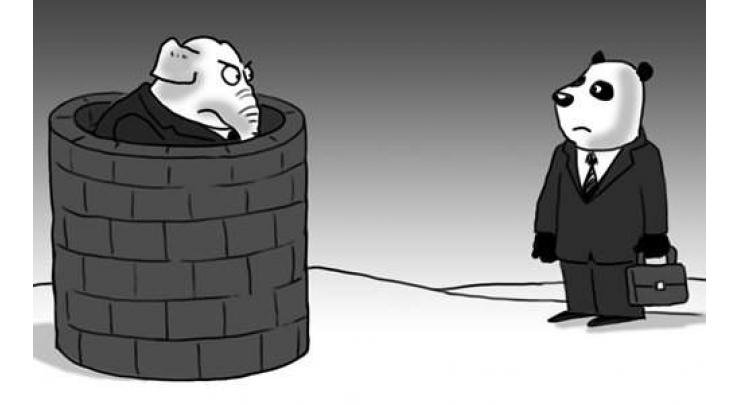
Indian Elites Stand To Gain From Advocating "China Threat" Theory
Rukhshan Mir (@rukhshanmir) Published July 31, 2017 | 05:10 PM

(APP - UrduPoint / Pakistan Point News - 31st Jul, 2017 ) The Bhutan government's declaration about the incident mentioned only disputes with China, and did not request interference by the Indian troops, so the first reason does not hold.
Indian experts and Bhutan scholars say that India's act was utterly for its own self-interest, according to an article published in Global Time on Monday. Security concerns about the "chicken's neck" show that India has seen China as a strategic threat for a long time, and made policies toward China accordingly.
The name "chicken's neck" leads to a false impression. The Siliguri Corridor is on a plain rather than a plateau. It only resembles a "chicken's neck" on a map, rather than a "neck" in a geographical or military sense.
Even if Chinese troops seize the 27-kilometer-wide corridor, this could in no way stop the movement of the Indian troops between the main bulk of Indian territory and its northeast. India knows this well enough and dwells on the "chicken's neck" to find an excuse for its intrusion into Doklam and to gain international support.
India has occupied too much Chinese territory already and fears China will recover it by force. India took over nine square kilometers of Chinese land in South Tibet based on the illegal McMahon Line, and then occupied vast undisputed areas north of it in 1951 when China was tied up by the Korean War.
India worries that if negotiations fail, China will take back these areas by force. With an economic strength five times greater than India's and a military budget three times that of India, China is naturally seen as a threat.
India also sees friendly relations between China and South Asian countries as a threat, for these countries are also neighbors of India. Counter to principles of international relations, India sees South Asia as its backyard.
Friendliness and partnership between its South Asian neighbors and other countries, especially big powers like China, is viewed as a threat by India. Close ties between China and Pakistan, for example, are a threat in India's eyes, although China maintains a neutral stance on the Kashmir conflict and encourages India and Pakistan to solve it in a peaceful manner.
India sees the entry of China's navy into the Indian Ocean as a threat, even though it is totally in line with international law. The Indian Ocean has become a crucial sea passage for China as its trade with countries in the region and Europe prospers.
But China's part in developing ports in Pakistan, Sri Lanka, Bangladesh and Myanmar is imagined by India as a "String of Pearls" to surround it. The Chinese navy's increased operations to safeguard navigational security in the high seas of the Indian Ocean are contained by India, with the support of the US, Japan and Australia, while other stakeholders such as Sri Lanka, the Maldives, Seychelles and Mauritius do not see a threat from China at all.
It is hard to understand India's groundless "China threat" theory. India probably just needs an enemy, even an imagined one. With multiple nationalities, religions and languages, plus intense internal conflicts and a strong centrifugal force pushing against national unity, India needs an external enemy as distraction.
China, with large border areas in dispute and the memory of the 1962 war, naturally fills that place. The earliest example of the "China threat" theory appeared in 1998, when then prime minister Atal Bihari Vajpayee used it as an excuse for nuclear tests in his letter to US president Bill Clinton.
Former defense minister George Fernandes said China was the No.1 threat to India. By preaching about the "China threat," politicians gain votes, military officers gain budget, media gain circulation and scholars gain popularity.
As a result, however, India puts too many resources into the military to confront China, while missing out on many opportunities to cooperate. In the end, it is the Indian people that are hurt badly in terms of lost development opportunities.
Taking China as a threat and adopting hostile measures against China, if overdone, may turn China into a real threat, and Indian elites should be careful how far they go.
Related Topics
Recent Stories

Punjab Chief Minister Maryam Nawaz Sharif pays tribute to martyr Major Babar

01 day medical camp held at Afiyat old age home

US retail sales misses expectations in April

Workshop on Innovative Leadership held at IBA Karachi

Pakistan team grabs bronze medal in Asian Taekwondo C'ship

US consumer inflation eases slightly in April, in good news for Biden

CM stresses quality education in govt schools

Pakistan conducts successful training launch of Fatah-II Guided Rocket System

'Maryam Ki Dastak', doorstep delivery of public services, launched

PM Shehbaz Sharif committed to building country’s climate resilience: Romina

Two production units fined Rs 125,000

Quality of Life Program Head discusses investment opportunities in Italy
More Stories From World
-

Quality of Life Program Head discusses investment opportunities in Italy
55 minutes ago -

Kuwaiti govt sworn in
55 minutes ago -

5.3-magnitude quake hits Tonga Islands
54 minutes ago -

Vice Foreign Minister Eng. Waleed Elkhereiji receives newly appointed Chinese Ambassador
1 hour ago -

Swiss court jails Gambian ex-minister for crimes against humanity
1 hour ago -
Two dead, hundreds injured as riots sweep New Caledonia
2 hours ago
-
Two dead, hundreds injured as riots sweep New Caledonia
2 hours ago -
Hezbollah says struck Israel after field commander's killing
2 hours ago -

Qatar eyes more long-term gas supply deals this year
1 hour ago -
Russia says advancing across front line including south
3 hours ago -
Palestinians flee Gaza battles on anniversary of 1948 'Nakba'
3 hours ago -

EU cuts inflation forecast for 2024 despite uncertainty
1 hour ago






